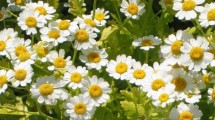Abstract
Phytomedicines may provide new options for migraine prophylaxis and treatment based on their historical use and pharmacological properties. However, as clinical data are limited, no phytomedicine can currently be strongly recommended to manage migraine. Feverfew and butterbur may be effective in preventing migraine, but the efficacy of butterbur has been overshadowed by reports of severe petasites hepatotoxicity. Although further research is needed, chamomile, coriander, peppermint and ginkgo have shown encouraging results in explorative clinical studies, and the active components of cannabis and St John’s wort have shown promise in preclinical studies.
Similar content being viewed by others
References
Noseda R, Burstein R. Migraine pathophysiology: anatomy of the trigeminovascular pathway and associated neurological symptoms, cortical spreading depression, sensitization, and modulation of pain. Pain. 2013;154(Suppl 1):S44–53.
Burstein R, Noseda R, Borsook D. Migraine: multiple processes, complex pathophysiology. J Neurosci. 2015;35:6619–29.
Headache Classification Committee of the International Headache Society. The international classification of headache disorders, 3rd edition. Cephalalgia. 2018;38:1–211.
Goadsby PJ, Holland PR, Martins-Oliveira M, et al. Pathophysiology of migraine: a disorder of sensory processing. Physiol Rev. 2017;97:553–622.
Rajapakse T, Davenport WJ. Phytomedicines in the treatment of migraine. CNS Drugs. 2019;33(5):399–415.
Levy D, Burstein R, Kainz V, et al. Mast cell degranulation activates a pain pathway underlying migraine headache. Pain. 2007;130:166–76.
De Weerdt CJ, Bootsma HP, Hendriks H. Herbal medicines in migraine prevention randomized double-blind placebo-controlled crossover trial of a feverfew preparation. Phytomedicine. 1996;3(3):225–30.
Pfaffenrath V, Diener HC, Fischer M, et al. The efficacy and safety of Tanacetum parthenium (feverfew) in migraine prophylaxis: a double-blind, multicentre, randomized placebo-controlled dose-response study. Cephalalgia. 2002;22(7):523–32.
Diener HC, Pfaffenrath V, Schnitker J, et al. Efficacy and safety of 6.25 mg t.i.d. feverfew CO2-extract (MIG-99) in migraine prevention—a randomized, double-blind, multicentre, placebo-controlled study. Cephalalgia. 2005;25:1031–41.
Murphy JJ, Heptinstall S, Mitchell JR. Randomised double-blind placebo-controlled trial of feverfew in migraine prevention. Lancet. 1988;2:189–92.
Palevitch D, Earon G, Carasso R. Feverfew (Tanacetum parthenium) as a prophylactic treatment for migraine: a double-blind placebo-controlled study. Phytother Res. 1997;11:508–11.
Holland S, Silberstein SD, Freitag F, et al. Evidence-based guideline update: NSAIDs and other complementary treatments for episodic migraine prevention in adults: report of the Quality Standards Subcommittee of the American Academy of Neurology and the American Headache Society. Neurology. 2012;78:1346–53.
Pringsheim T, Davenport WJ, Mackie G, et al. Canadian Headache Society guideline for migraine prophylaxis. Can J Neurol Sci. 2013;40(5 Suppl 3):S1–80.
Evers S, Afra J, Frese A, et al. EFNS guideline on the drug treatment of migraine–revised report of an EFNS task force. Eur J Neurol. 2009;16(9):968–81.
McGuffin M. American Herbal Products Association’s botanical safety handbook. Boca Raton: CRC Press; 1997.
Shimoda H, Tanaka J, Yamada E, et al. Anti type I allergic property of Japanese butterbur extract and its mast cell degranulation inhibitory ingredients. J Agric Food Chem. 2006;54:2915–20.
Lipton RB, Göbel H, Einhäupl KM, et al. Petasites hybridus root (butterbur) is an effective preventive treatment for migraine. Neurology. 2004;63:2240–4.
Diener HC, Rahlfs VW, Danesch U. The first placebo-controlled trial of a special butterbur root extract for the prevention of migraine: reanalysis of efficacy criteria. Eur Neurol. 2004;51:89–97.
Tepper SJ. Evidence-based basics on neutraceutical herbs, minerals, vitamins and supplements in migraine management. https://americanheadachesociety.org/wp-content/uploads/2018/06/Tepper-Nutraceuticals.docx. Accessed Jun 2019.
Diener HC, Freitag FG, Danesch U. Safety profile of a special butterbur extract from Petasites hybridus in migraine prevention with emphasis on the liver. Cephalalgia Rep. 2018;1:1–8. https://doi.org/10.1177/2515816318759304.
Pittler MH, Ernst E. Feverfew for preventing migraine. Cochrane Database Syst Rev. 2004;CD002286.
Wider B, Pittler MH, Ernst E. Feverfew for preventing migraine. Cochrane Database Syst Rev. 2015;4:CD002286.
Delavar Kasmaei H, Ghorbanifar Z, Zayeri F, et al. Effects of Coriandrum sativum syrup on migraine: a randomized, triple-blind, placebo-controlled trial. Iran Red Crescent Med J. 2016;8(1):e20759.
Kamali M, Seifadini R, Kamali H, et al. Efficacy of combination of Viola odorata, Rosa damascena and Coriandrum sativum in prevention of migraine attacks: a randomized, double blind, placebo-controlled clinical trial. Electron Physician. 2018;10:6430–8.
Kasper S, Caraci F, Forti B, et al. Efficacy and tolerability of hypericum extract for the treatment of mild to moderate depression. Eur Neuropsychopharmacol. 2010;20(11):747–65.
Borhani Haghighi A, Motazedian S, Rezaii R, et al. Cutaneous application of menthol 10% solution as an abortive treatment of migraine without aura: a randomised, double-blind, placebo-controlled, crossed-over study. Int J Clin Pract. 2010;64:451–6.
Niazi M, Hashempur MH, Taghizadeh M, et al. Efficacy of topical Rose (Rosa damascena Mill) oil for migraine headache: a randomized double-blinded placebo-controlled cross-over trial. Complement Ther Med. 2017;34:35–41.
Fan P. Cannabinoid agonists inhibit the activation of 5-HT3 receptors in rat nodose ganglion neurons. J Neurophysiol. 1995;73:907–10.
Baron EP. Comprehensive review of medicinal marijuana, cannabinoids, and therapeutic implications in medicine and headache: what a long strange trip it’s been. Headache. 2015;55:885–916.
Williamson EM, Evans FJ. Cannabinoids in clinical practice. Drugs. 2000;60:1303–14.
Aggarwal SK. Cannabinergic pain medicine: a concise clinical primer and survey of randomized-controlled trial results. Clin J Pain. 2013;29:162–71.
Zargaran A, Borhani-Haghighi A, Salehi-Marzijarani M, et al. Evaluation of the effect of topical chamomile (Matricaria chamomilla L.) oleogel as pain relief in migraine without aura: a randomized, double-blind, placebocontrolled, crossover study. Neurol Sci. 2018;39(8):1345–53.
Galeotti N, Ghelardini C. St. John’s wort reversal of meningeal nociception: a natural therapeutic perspective for migraine pain. Phytomedicine. 2013;20:930–8.
Author information
Authors and Affiliations
Consortia
Ethics declarations
Conflict of interest
The article was adapted from CNS Drugs 2019; 33(5):399–415 [5] by employees of Adis International Ltd./Springer Nature, who are responsible for the article content and declare no conflicts of interest.
Funding
The preparation of this review was not supported by any external funding.
Rights and permissions
About this article
Cite this article
Adis Medical Writers. Some phytomedicines show promise for the management of migraine, but further clinical evidence is needed before they can be strongly recommended. Drugs Ther Perspect 35, 413–417 (2019). https://doi.org/10.1007/s40267-019-00657-1
Published:
Issue Date:
DOI: https://doi.org/10.1007/s40267-019-00657-1



